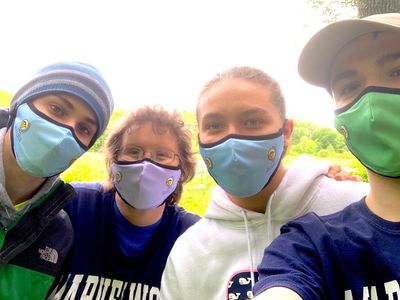The Marvelwood School is an intentionally small school in the northwest corner of Connecticut. The school, as part of its science curriculum and community service programs, has a strong history of conservation work in the local community. I have always tried to engage and inspire the next generation of conservationists via project-based learning experiences at Marvelwood.
In 1995 the school moved from the town of Cornwall to Kent, CT. Shortly after the school arrived on Skiff Mountain in Kent, our neighbors and local conservation organizations solicited our assistance to document species to help save approximately 450 acres of land surrounding our new campus. The land was slated for subdivision and development. Since two of the school’s four core values are Service and Responsibility we naturally jumped in and offered to contribute our time to help protect the land!
Realizing that we would need to scientifically document the fauna discovered, particularly the birds, we obtained permission from the organization selling the land, and a local landowner, to create three MAPS stations to the North, South, and East of the campus for “educational” purposes. We started our first station in 2001 to the south of the campus and then added our station to the east and our north station. Local and international students would stay on campus to help with these banding efforts. The mission to save the land was not going well until a very special bird, already listed as endangered in the state, landed in our mist nets.
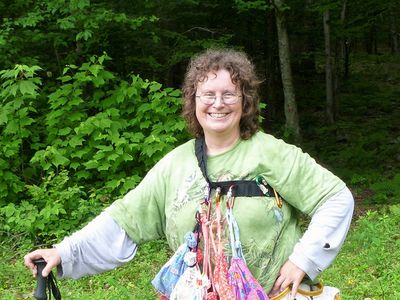
The capture and documentation of a male Golden-Winged Warbler during a MAPS banding session, with physiological evidence of breeding, finally helped sway the various town commissions involved in granting development permits, to pause further project approvals until a full one-year environmental impact assessment could be conducted. Once the environmental importance of the land was discovered, the developers agreed to sell the land to the Trust for Public Lands, Sharon Land Trust and Kent Land Trust. A 1.26 million dollar Open Space and Watershed Land Acquisition Grant from the Connecticut Department of Environmental Protection secured the deal to purchase the habitat creating a conservation easement permanently adding another layer of protection. Sharon Land Trust gained ownership of Skiff Mountain North Preserve and Kent Land Trust became responsible for Skiff Mountain South Preserve. The neighbors who also had fought so hard to help save Skiff Mountain placed their land in the U.S. Forest Service Forest Legacy Program resulting in the protection of over 700 acres around our campus.
Energized by efforts to help save the land, Marvelwood continued to engage in MAPS banding in partnership with one of the land trusts instrumental in helping to save Skiff Mountain, the Kent Land Trust. We wanted to ensure that now that the land was safe from development, habitat in Skiff Mountain South Preserve would be managed for the avian species breeding on the property. Marvelwood School and Kent Land Trust volunteers helped to restore an old overgrown meadow surrounded by forest. This led to the creation of our SKIF banding station at the opposite end of the preserve from our BEAV banding station. Local children and KLT volunteers would soon increase their participation and join Marvelwood students in our MAPS banding efforts. Banding around this newly restored forest gap led to the discovery of a pocket of breeding Cerulean Warblers along with Worm-eating Warblers and Wood Thrush. In fact, one female Cerulean Warbler was captured and banded on June 10, 2012, and then recaptured in the exact same net on June 13, 2017!
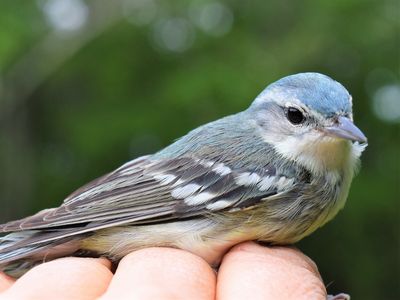
Another highlight at our MAPS banding station was in 2012 when a banded Cooper’s Hawk landed in our mist nets at BEAV banding station in June and then again at RACK banding station in July. The bird had originally been banded on October 8, 2010, in Cape May County in New Jersey as a hatch year male. The original banders were delighted to receive information about this bird as well as pictures, which they reported they rarely receive.
Student-driven data obtained from our banding station was also key in the designation of a landscape level Important Bird Area, the Macedonia Forest Block. Thanks to our MAPS banding stations the IBA met numerous criteria including long-term research and/or monitoring projects that contribute substantially to ornithology, bird conservation, and/or education and are important to species of global concern particularly Cerulean Warbler and Wood Thrush.
Over the years, students and Kent Land Trust volunteers have created interactive bird trails, secured grants to soften edges by planting native species and provided educational programs about birds and habitat management for local children and adults. Recently we contributed key physiological evidence via our MAPS banding data to confirm breeding species for the CT Bird Atlas Project.
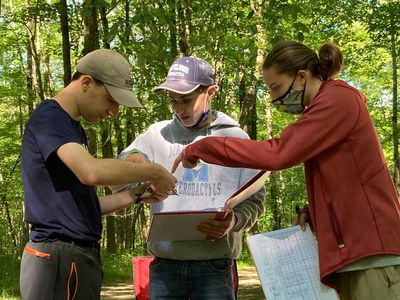
Banding highlights throughout the years, in addition to those already mentioned, include Winter Wren, Black-Billed Cuckoo, Yellow-throated Vireo, Hermit Thrush, Hooded Warbler, Least Flycatcher, Black-throated Blue Warbler, Ruffed Grouse, Black and White Warbler, American Woodcock, Broad-winged Hawk, Scarlet Tanager, Eastern Towhee and Lawrence’s Warbler (hybrid). Interesting non-avian experiences include being sprayed by a skunk; dealing with a long-tailed weasel with attitude intimidating one of our volunteer banders; and multiple black bear encounters, including one who charged one of my students while he was trying to extract a Red-eyed Vireo.
The most important contribution of our long-term MAPS stations on Skiff Mountain, where we have banded and/or extracted over 65 bird species, has been in raising awareness within the Kent Land Trust, the local community, and young people about birds and their conservation needs. As a teacher, I first secured a sub-permit under Laurie Fortin and eventually obtained my own master permit, to use birds as a vehicle to protect land from development, establish a landscape level IBA, better manage habitat for birds, and impress upon my students the importance of volunteering their time to assist in conservation efforts. I constantly remind my students that we all have a responsibility to use our skills, time, and knowledge to help others in our community understand and protect the incredible avian biodiversity we are blessed with on Skiff Mountain. We came so close to losing land critical to many breeding birds of conservation concern and data generated from our participation in the MAPS program was key in helping to save the land. We continue to stay involved in the MAPS program so that our data can also contribute to a better understanding of bird populations and efforts to conserve bird species at both a local and continental level. Our students, through their volunteer efforts, are contributing to science and educating people in the Kent area about the importance of providing quality habitats for birds.
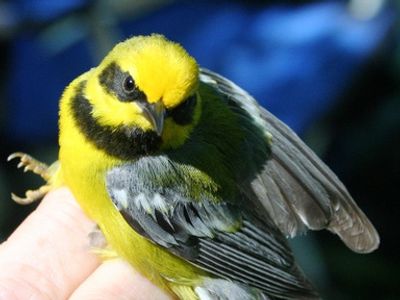
I am grateful to all the biologists and researchers at The Institute for Bird Populations for their knowledge and assistance to allow us to participate in the MAPS program. I would also like to thank Kent Land Trust for their commitment to better understanding birds and their life cycle needs on their properties, financial support, and providing banding interns. I am also thankful to Kent School Alumni (our current campus was originally the campus for girls at Kent School) and Marvelwood School for their financial support to continue to operate our MAPS stations. Finally, I would like to thank my mentor Laurie Fortin, long-time banding partner Janet Allison and all the students and KLT banding volunteers these past 21 years. Community partnerships really do work and collaborative efforts like we have on Skiff Mountain are key to understanding and conserving habitat for birds. Perhaps David Attenborough best summed up what we have been doing on Skiff Mountain for the past 21 years by stating “No one will protect what they don’t care about, and no one will care about what they have never experienced.”
We appreciate the Institute for Bird Populations and their MAPS program for giving us the tools to help make our community care about birds and the resources in our little corner in Connecticut and the habitats they need to thrive.
